8+ SAMPLE Construction Accident Report
-
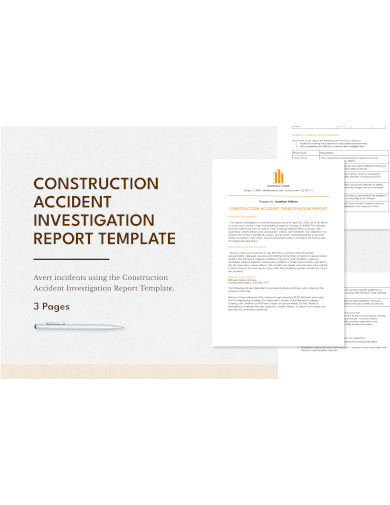
Construction Accident Investigation Report
download now -
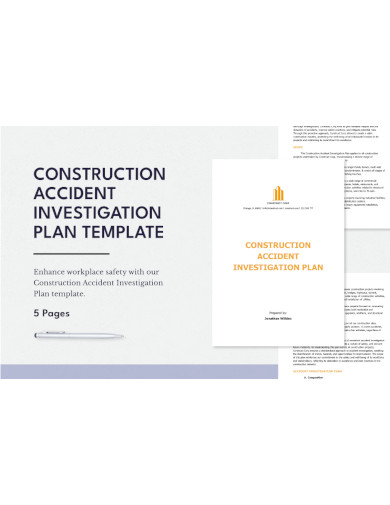
Construction Accident Investigation plan Report
download now -
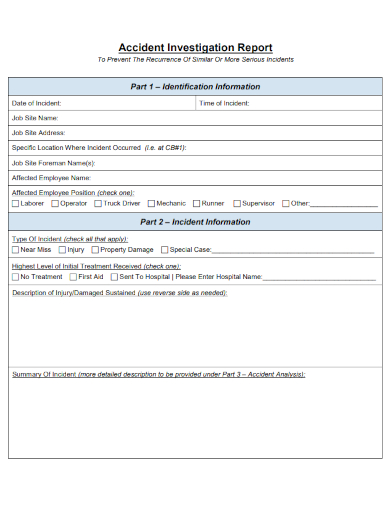
Sample Construction Accident Investigation Report
download now -
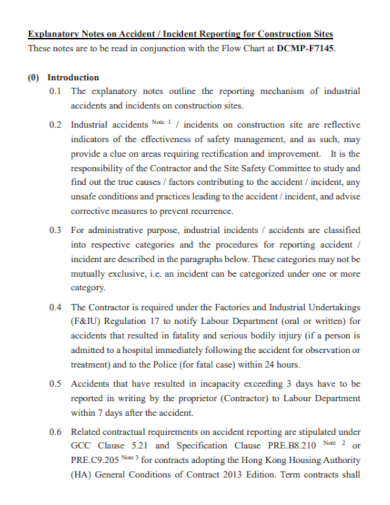
Construction Site Accident Incident Report
download now -
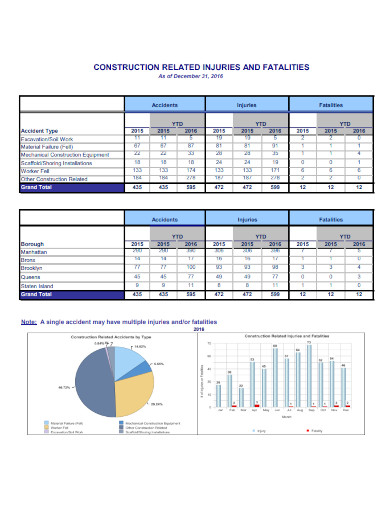
Construction Accident Summary Report
download now -
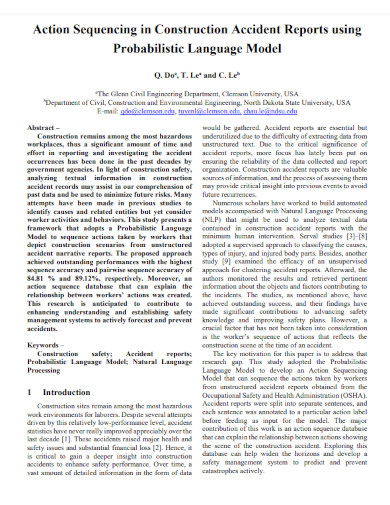
Action Sequencing in Construction Accident Reports
download now -
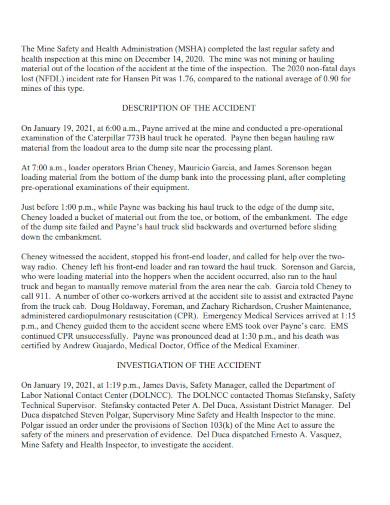
Fatal construction Accident Investigation Report
download now -

Fatal construction Accident Investigation Report
download now -
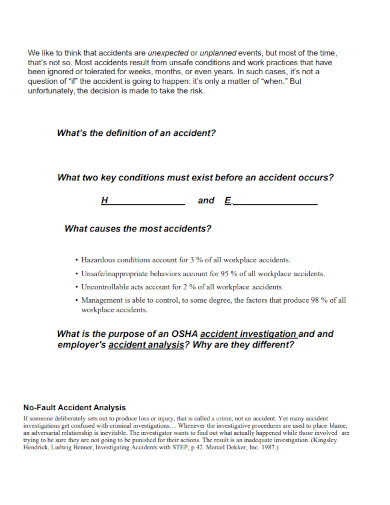
construction Accident Report Analysis
download now -
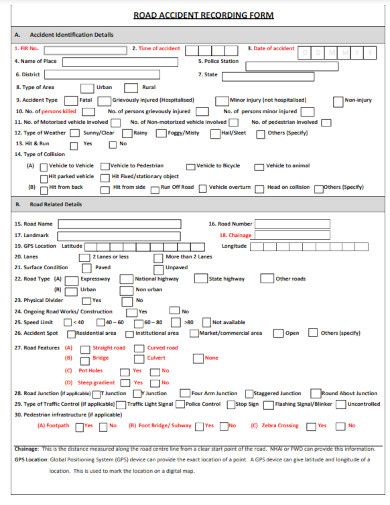
Construction Road Accident Report Recording Form
download now
FREE Construction Accident Report s to Download
8+ SAMPLE Construction Accident Report
What is Construction Accident Report ?
Key Elements of Construction Accident Report
Why is a Construction Accident Report Important
What is Construction Accident Report ?
1. Documentation: It provides a comprehensive account of what happened, including the date, time, location, individuals involved, and a description of the incident itself.
2. Legal and Regulatory Compliance: Construction Accident Reports help ensure compliance with legal and regulatory requirements. Many countries and regions have strict safety regulations in place, and reporting accidents is often a legal obligation.
3. Safety Improvement: By analyzing the information in Work accident reports, construction companies can identify trends and common causes of accidents. This data can be used to develop and implement safety measures and best practices to prevent future accidents.
4. Insurance Claims: In the event of an injury or property report damage, a well-documented accident report is often required for insurance purposes. It can help in processing insurance claims.
5. Communication: Sharing accident reports with workers, management, and stakeholders can promote transparency and accountability within a construction project. It helps in addressing concerns and ensuring that safety measures are taken seriously.
A typical construction accident report includes details such as the date and time of the accident, the location, a description of the incident, the names of individuals involved, any witnesses, injuries sustained, actions taken at the scene, medical treatment provided, and corrective actions to prevent future accidents.
Accurate and thorough reporting is essential to ensure a safe working environment on construction sites and to protect the well-being of all workers and the integrity of the project.
You May Also See SAMPLE Accident And Incident Report, SAMPLE Injury Incident Report
Key Elements of Construction Accident Report
A well-structured construction accident report should include the following key elements to provide a comprehensive account of the incident and its aftermath:
- Date and Time: Record the exact date and time when the accident occurred. This information is crucial for establishing a timeline.
- Location: Specify the precise location within the construction site where the accident took place. Include details such as the building or area name and its specific position on the site.
- Incident Details: Provide a thorough description of the incident, including what happened, how it happened, and any contributing factors. Be as detailed as possible.
- Injuries Sustained: List and describe all injuries sustained by individuals involved, including their severity. This may include physical injuries, illnesses, or psychological trauma resulting from the accident.
- Individuals Involved: Include the names and contact information of all individuals directly involved in the accident, such as the injured party, witnesses, and any other personnel who played a role in the incident.
- Immediate Actions Taken: Describe the actions taken immediately after the accident, such as administering first aid, calling emergency services (if required), and securing the accident scene.
- Supervisor/Foreman on Duty: Identify the supervisor or foreman who was on duty at the time of the accident. Provide their name and contact information.
- Medical Treatment: Detail the medical treatment provided to the injured party, including the name and contact information of the healthcare facility where they were taken for treatment.
- Property Damage: If equipment or property was damaged as a result of the accident, specify what was damaged and provide an estimated value of the damage.
- Photographs and Evidence: Include any photographs, diagrams, or other visual evidence that can help in understanding the accident scene or the causes of the incident.
- Witness Statements: Gather statements from any witnesses, documenting their observations and perspectives on the accident.
- Corrective Actions: Outline the corrective actions that will be taken to prevent similar accidents in the future. This could include safety protocol adjustments, additional training, or equipment maintenance.
- Additional Comments: Use this section for any other relevant information or comments that may not fit into the above categories.
- Completed By: Include the name of the person completing the report, their title, and contact information.
- Date of Report: Note the date when the report is being completed.
- Signature: Provide a space for the signature of the person completing the report to certify its accuracy.
You May Also See Incident Report Sample, Sample Contractor Report.
Writing a construction accident report is a critical process to document incidents and ensure workplace safety. Here’s a step-by-step guide on how to write a construction accident report:
- Gather Information: Begin by collecting all relevant information about the accident. This includes the date, time, location, individuals involved, and witnesses. Ensure you have accurate and comprehensive data.
- Use a Standard Template: Many organizations have standardized accident report forms or templates. Use the provided template if available, as it helps ensure consistency and compliance with company procedures.
- Title and Heading: Create a clear and informative title for the report. Include a heading with the date, time, and location of the accident.
- Description of the Accident: Start with a detailed description of the accident. Explain what happened, how it happened, and any contributing factors. Use clear and concise language to make the incident easily understood.
- Injuries and Damages: List and describe all injuries sustained by individuals involved, specifying their severity. If any equipment or property was damaged, detail what was damaged and provide an estimated value of the damage.
- Witness Statements: Include statements from any witnesses. Document their observations and perspectives on the accident.
- Immediate Actions Taken: Describe the actions taken immediately after the accident. This may include administering first aid, calling emergency services, or securing the accident scene.
- Medical Treatment: Detail the medical treatment provided to the injured party, including the name and contact information of the healthcare facility where they were taken for treatment.
- Supervisor/Foreman on Duty: Identify the supervisor or foreman who was on duty at the time of the accident. Provide their name and contact information.
- Photographs and Evidence: If available, include photographs, diagrams, or other visual evidence that can help in understanding the accident scene or the causes of the incident.
- Corrective Actions: Outline the corrective actions that will be taken to prevent similar accidents in the future. This could include safety protocol adjustments, additional training, or equipment maintenance.
- Additional Comments: Use this section for any other relevant information or comments that may not fit into the above categories.
- Completed By: Include the name of the person completing the report, their title, and contact information.
- Date of Report: Note the date when the report is being completed.
- Signature: Provide a space for the signature of the person completing the report to certify its accuracy.
- Review and Distribute: After completing the report, review it for completeness and correctness. Once reviewed and approved, distribute copies to relevant parties, such as supervisors, safety officers, and any necessary regulatory authorities.
Remember that a well-documented construction accident report is essential for improving safety on construction sites, ensuring regulatory compliance, and preventing future accidents. Completing it accurately and promptly is crucial.
- Gather Information: Collect all relevant information about the accident. This includes the date, time, location, individuals involved, witnesses, and any other pertinent details. Ensure you have accurate and comprehensive data.
- Use a Standard Template: Many organizations have standardized accident report forms or templates. Utilize the provided template if available, as it helps ensure consistency and compliance with company procedures.
- Title and Heading: Start by creating a clear and informative title for the report. Include a heading with the date, time, and location of the accident.
- Description of the Accident: Provide a detailed description of the accident. Explain what happened, how it happened, and any contributing factors. Use clear and concise language to make the incident easily understood.
- Injuries and Damages: List and describe all injuries sustained by individuals involved, specifying their severity. If any equipment or property was damaged, detail what was damaged and provide an estimated value of the damage.
- Witness Statements: Include statements from any witnesses. Document their observations and perspectives on the accident.
- Immediate Actions Taken: Describe the actions taken immediately after the accident. This may include administering first aid, calling emergency services, or securing the accident scene.
- Medical Treatment: Detail the medical treatment provided to the injured party, including the name and contact information of the healthcare facility where they were taken for treatment.
- Supervisor/Foreman on Duty: Identify the supervisor or foreman who was on duty at the time of the accident. Provide their name and contact information.
- Photographs and Evidence: If available, include photographs, diagrams, or other visual evidence that can help in understanding the accident scene or the causes of the incident.
- Corrective Actions: Outline the corrective actions that will be taken to prevent similar accidents in the future. This could include safety protocol adjustments, additional training, or equipment maintenance.
- Additional Comments: Use this section for any other relevant information or comments that may not fit into the above categories.
- Completed By: Include the name of the person creating the report, their title, and contact information.
- Date of Report: Note the date when the report is being created.
- Signature: Provide a space for the signature of the person creating the report to certify its accuracy.
- Review and Distribute: After creating the report, review it for completeness and correctness. Once reviewed and approved, distribute copies to relevant parties, such as supervisors, safety officers, and any necessary regulatory authorities.
A well-documented construction accident report is crucial for improving safety on construction sites, ensuring regulatory compliance, and preventing future accidents. Creating it accurately and promptly is essential.
You May Also See SAMPLE Insurance Incident Report.
Why is a Construction Accident Report Important
Construction accident reports are vital for safety and compliance. They help identify hazards, prevent future incidents, and ensure legal and insurance requirements are met.
In summary, this comprehensive guide on crafting a construction accident report provides valuable insights, tips, and a step-by-step approach. By following this guide, you’ll not only ensure compliance but also improve safety protocols. Make every incident a lesson, reinforcing safety measures and contributing to a safer construction industry. Your report is your roadmap to a secure and efficient work environment
